Butternut squash is a healthy, versatile and incredibly flavorful winter squash that is luckily available year round in most grocery stores these days. It can be prepared in a variety of ways. Pureed butternut squash makes a wonderful base for soups, sauces and pies. When diced and roasted, it's an excellent addition to pastas and whole grain salads (it can also be pureed after roasting). Let's explore two common methods for cooking butternut squash: sliced in half with the skin left on, and peeled and diced.
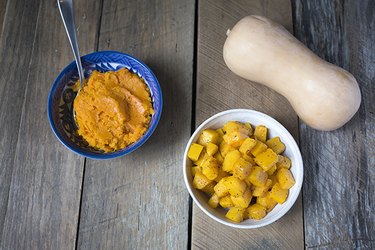
Video of the Day
Things You'll Need
Baking sheet covered with aluminum foil
Cutting board
Very sharp chef's knife
Vegetable peeler (for diced butternut squash)
Butternut squash
Extra virgin olive oil
Salt and ground black pepper
Optional seasonings: ground cinnamon, nutmeg, allspice
Gather Your Ingredients and Tools
Regardless of whether you're cooking whole or diced butternut squash, you will need the following: a large baking sheet covered in aluminum foil (the foil is technically optional but will make cleanup a breeze), a cutting board, and a very sharp knife. Raw butternut squash is very firm, and a dull knife could potentially lead to injuries. If you do not own a sharp knife, I highly recommend purchasing pre-diced butternut squash, which is available in the produce aisles of most grocery stores. You will also want extra virgin olive oil for roasting (other oils may be substituted based on preference), as well as salt and pepper. As with most roasted vegetables, salt and pepper is technically all you need, but butternut squash pairs especially well will spices such as cinnamon, nutmeg, and allspice (pumpkin pie spice blends are also a nice option). If you're dicing the squash, you will need a vegetable peeler.
Video of the Day
Tip
To save time, you can purchase pre-diced butternut squash in the produce section of most grocery stores.
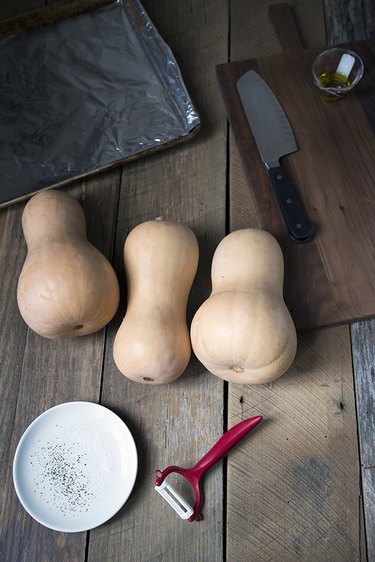
Roasting Squash Sliced in Half
Preheat the oven to 400 degrees F.
Slice the Squash in Half Lengthwise
If you're roasting the squash whole, it does not need to be peeled first. Depending on the roundness of the top and bottom of the squash, you might want to carefully slice off the ends before cutting the squash lengthwise. You always want to cut against a flat surface so that the squash is not rolling. Slice the squash in half from top to bottom, keeping your fingers safely out of the way.

Remove the Seeds
Use a large spoon to remove the seeds (they can be saved and roasted like pumpkin seeds, or you can discard them).
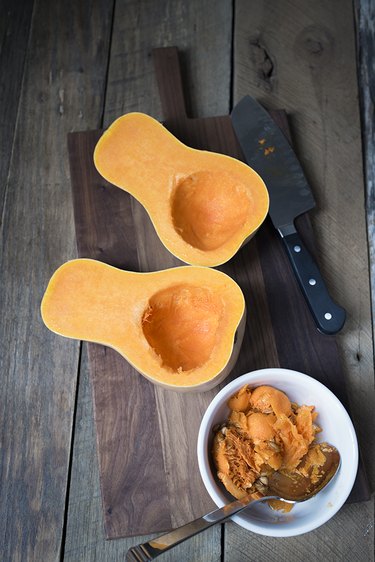
Coat With Olive Oil
Coat the cut side of the squash with a thin layer of olive oil (the goal is simply to keep it from sticking to the foil) and place it cut side down.
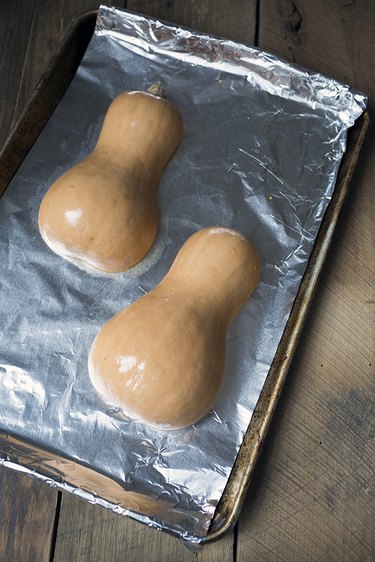
Roast Until Tender
Roast the squash until tender, which can take anywhere from 40 to 60 minutes. The time will vary depending on the size of the butternut squash. You can tell the squash is ready when you press on the skin and it gives. Remove from the oven, allow to cool for a few minutes, and then use a spatula to flip.
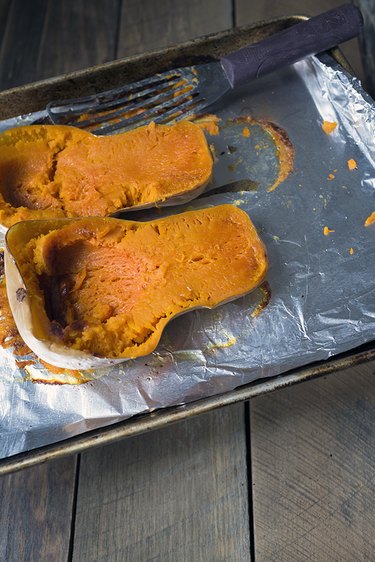
Scoop and Serve
Use a large spoon to scoop the cooked squash into a bowl, discarding the skin. It's wonderful served plain, or you can add additional seasonings to taste.
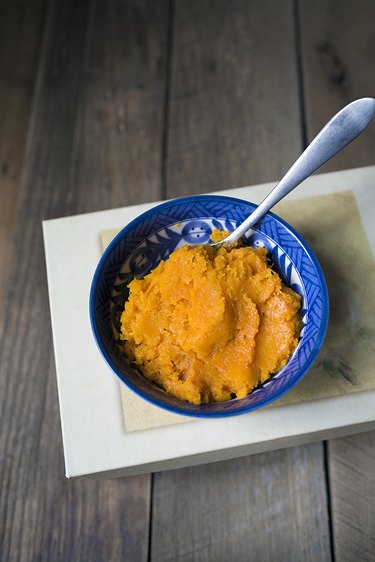
Roasting Peeled and Diced Squash
If you're peeling and dicing the squash, the steps are basically the same with a few exceptions. Before slicing the squash in half, use a vegetable peeler to remove the thick outer layer of skin. You might find it easier to dice the squash if you cut it in half again after slicing it down the middle and removing the seeds. Keep in mind that the smaller the dice, the shorter the roasting time.

Toss with Olive Oil, Salt and Pepper, Then Roast
After dicing the squash, toss it liberally with olive oil, salt and pepper. Place in the oven and roast, stirring every 10 to 15 minutes to ensure even cooking. The squash can technically be cooked at any temperature between 350 to 425 degrees F. The higher the temperature, the shorter the cook time and the better chance you have for caramelization, if that's your preference.

Serve Diced or Pureed
Once roasted, diced butternut squash can either be served roasted, or it can be pureed in a food processor for soups and sauces.
